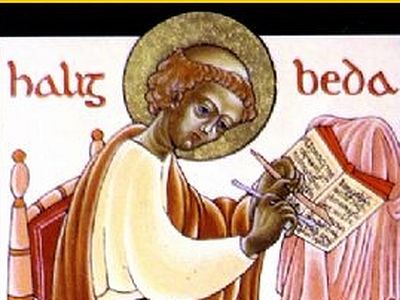Source: Chronicle Live
A long-lost cast of the skull of one of the North East’s greatest sons has been discovered in a box in a storage cupboard at Cambridge University.
The cast of what is believed to be the top of the head of the Venerable Bede, one of Europe’s leading scholars whose works are still in print today, was originally taken when his tomb at Durham Cathedral was opened in 1831.
It was one of three commissioned by Dr James Raine, who also investigated St Cuthbert’s tomb in the cathedral in 1827.
Professor Richard Bailey, from Newcastle University, set out in the 1980s to discover the fate of the casts.
He said: “When working on the cult of Bede, I discovered Dr Raine’s handwritten note which showed that he had ordered three casts of the skull he had found in Bede’s tomb.
“I tracked the subsequent fate of one of them through to the Newcastle Society of Antiquaries but it had disappeared by 1900. Every other trail I tried to follow went cold on me.”
Now one of the casts as been discovered by chance by Leicester University’s Professor Joanna Story which carrying our research at Cambridge.
“It is a fascinating find,” said Prof Bailey, who lives in Ponteland and was formerly Deputy Vice-Chancellor and Professor of Anglo-Saxon Civilisation at Newcastle University.
Bede, known as the ‘Father of English History’ lived and worked at the twin monastery of Jarrow-Wearmouth, and died in AD735.
Now, a cast has been taken of the Cambridge find and will go on show at Bede’s World in Jarrow from Tuesday.
When Dr Raine excavated the tomb of Bede in Durham Cathedral, he found a partial skeleton and a medieval ring.
The bones had been venerated throughout the Middle Ages as those of Bede.
The medieval tomb was destroyed at the Reformation in 1542 but the bones it contained were later carefully laid out in a new tomb in the Galilee Chapel at the western end of the cathedral, where they remain today.
It is believed Bede’s remains were removed from Jarrow in the 11th Century and taken to Durham, where they were placed in a linen bag in the coffin of St Cuthbert.
One of the Raine casts was given to John Thurnam, an asylum doctor and antiquarian who built up a collection of skulls, some from excavations.
At the time it was thought that skulls could provide information on brain function, racial characteristic and the nature of past people.
The Thurman collection ended up in the Duckworth Laboratory in the Leverhulme Centre for Human Evolutionary Studies at the University of Cambridge, where Prof Story made her discovery.
The new Jarrow exhibition explores the medieval devotion to Bede, and the discovery, preservation, and fierce debate about the authenticity of the skull in the mid-19th century.
Prof Story said: “The story of the skull of Bede is one that takes us to the heart of 19th-Century ideas about race and the peopling of the British Isles in antiquity.
“It traces the thread of evidence that links the cast in the Cambridge cupboard back to the excavation of Bede’s tomb in Durham Cathedral in 1831, and from there back to the destruction of the medieval shrines of saints in Reformation England, the devotion to the memory of Bede throughout the Middle Ages, to the creation of Durham Cathedral in early 12th century Norman England.”
Matt Storey, of Bede’s World, said: “Not only is it exciting that we have been able to acquire a cast of the skull of Bede for permanent display at the museum, but the story behind the cast opens up a number of fascinating questions about what happened to Bede’s bones after his death along with the celebration of his cult in medieval Europe.
“The project has been a very successful collaboration between Bede’s World, the University of Leicester and the University of Cambridge and I hope that there will be further opportunities for us to work together in the future.


